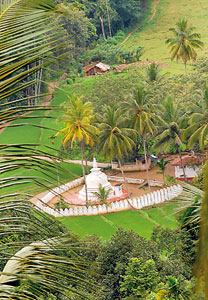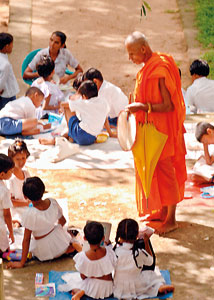To be offered a copy of a well-presented coffee table book relevant to the Vesak season was a pleasant surprise. The theme is timely, the text excellent, the pictures beautiful, the layout pleasing and the print clean. What more?
In an effort to present the traditional village which is fast disappearing, renowned scholar Professor J. B. Disanayaka wrote 'The Monk and the Peasant' two decades ago. The book took us on a nostalgic journey. The Kandyan village in Kegalle district where he was born and bred was different in some aspects to mine in the Gampaha district. Yet there were so many similarities, particularly the visits to the village temple accompanying mother over the paddy fields and taking part in the rituals on Poya days.
'The Monk and the Peasant' is an elegant and attractive coffee table book – the first by JB who has to his credit, over two dozen books written in English on culture, language and linguistics. The photographs are by internationally recognized photographer Tilak Hettige. He is presently in the Philippines as a faculty member of the Philippine Center for Creative Imaging (PCCI). JB has been fortunate in getting him to travel to many parts of Sri Lanka and pick suitable pictures to illustrate his text.
 |
 |
| Tilak Hettige’s photographs illustrate the text |
Tilak captures the concept of the affinity of the temple and the village with a double page spread of a dagaba and a Bo-tree in the midst of a lush green paddy field to adorn the opening pages of the book, followed immediately after with another double page spread featuring a peasant with a dagaba towering high on the hill top.
Photographer turned layout artist, Tilak uses the pictures generously to illustrate the text – most of them covering full pages thereby creating the desired impact. I wished picture captions were used to identify each and every picture. Although a page has been devoted to the captions at the end of the book, it is not a complete list. Many readers would like to identify the locations where the photographs have been taken, particularly those featuring temple frescoes.
As for the text, JB has tried to make it simple and readable, as he always does. He confesses that no village today exhibits all the elements he describes but each and every element presented in the book still exists in one village or another. "My 'traditional Sinhalese village' is therefore not a myth; it is an image of what it was in its original and complete form, reconstructed on the basis of surviving aspects and other evidence," he explains.
In his preface which he titles 'Thus it came to pass', JB points out several factors which compelled him to write the book. One is the need to clarify the term 'Buddhist values'', which he says, is very often heard on public platforms of all kinds "as a catchall signifying almost nothing or something vague." He describes the term as one "which can be precisely defined to embrace the system of ethical and moral values that inspires and governs the behavioural patterns of the Buddhist monk and the peasant." Saying that these values are among the most positive aspects of a culture, he insists that these must be retained at all cost.
Pointing out that national integration was another factor that motivated him to undertake a study of this nature, JB goes on to explain what he thinks should be achieved. "Sri Lanka today is in the throes of a crisis, almost unparalleled in her history.
The age in which one could legitimately speak of a single Sinhalese Buddhist society is gone. We are now a multi-ethnic, multi-lingual and multi-religious society struggling to come to terms with conflicting claims. National integration, in my view, does not mean the simplistic creation of a hybrid culture which is neither here nor there. It is certainly not a hodge-podge of incongruous elements from different cultures brought together under stress. National integration should not be a move to erase the individual identities of the different ethnic, linguistic and religious groups that make up Sri Lankan society but only a move to allow these groups to maintain their uniqueness without any barriers. It must ensure the creation of a political, legal and socio-cultural climate necessary for each ethnic group to live with others in peace, harmony and dignity."
To achieve such integration, JB emphasises that Sri Lankans must strive with determination to understand and appreciate not only the similarities but also the differences that exist among cultures. Rejecting sweeping statements such as 'all cultures are the same' as false and misleading, he says that we should look for a world without barriers and not a world where everything is not the same. He hopes that his study of the traditional village will help members of other ethnic groups to understand and appreciate the similarities and differences that exist between cultures.
Throughout the book JB cleverly uses the Sinhala terms frequently used in the village with simple English equivalents so that even a reader unfamiliar with commonly used Sinhala terminology is comfortable. It also reminds the reader of many terms that are fast disappearing from day-to-day usage. So is the ability of the reader to distinguish the terminology used in different parts of the country.
The book contains 18 chapters organized into five main themes – the village, the temple, the monk, the peasant, and the values. In discussing the village, JB identifies two tracts of sacred land - the temple (pansala) and the threshing floor (kamata) – the former deriving its sanctity from Buddhism and the latter from Sinhalese folk religion. To him, Sinhalese folk culture is a synthesis through a harmonious interaction between these two sacred lands and those associated with them: the monk (hamuduruvo) and the peasant (goviya). He goes on to describe the activities connected with the two places.
JB distinguishes the different aspects of the temple. It is the land of the faithful where the village community conducts their religious observances. It is the school without walls where the peasant is informally tutored in moral education. It is the haven of the artist - the one who draws, the one who plays the drum and the one who dances. The role each plays in relation to the temple is explained in detail.
JB discusses the monk's daily routine, his role as a teacher, his responsibilities in organising the rituals particularly during the vas or rainy season, and his relationship with the village.
His description of the activities connected with the threshing floor is fascinating. So is his explanation of the language used by the peasant at home and at the sacred land. A chapter is devoted to pilgrimages which the peasant undertakes to acquire merit.
It is an encouraging sign that at a time when printing costs are escalating, DIMO have stepped in to sponsor the publication. Printed by Gunaratne Offset, this is a Sumitha book and is distributed by Sarasavi Bookshop (Pvt)Ltd.
In 'The Monk and the Peasant', there is now a quality product which anyone who loves Sri Lanka and Sri Lankan culture can treasure. |



